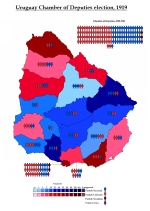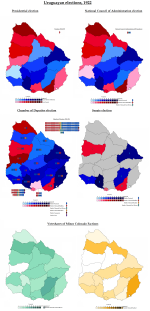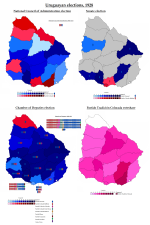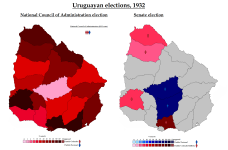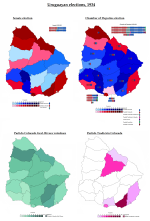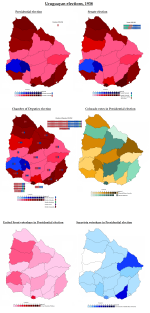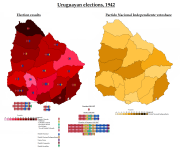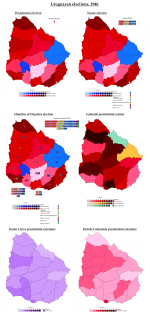President Serrato chose his Ministers from all factions of the Colorado Party, including the Batllistas - but the Batllista Colorados who had provided the bulk of Serrato’s votes decided to bring down every single one of his starting line-up, including one of their own. Various fights were picked over personal and policy issues: Pedro Manini Rios, the Riverista, was once again sacked. The most important of these was a dispute over compulsory military training. Serrato promoted it as a way of ‘nationalising’ the Army (i.e. incorporating the Nationalist supporters who tended to boycott it as a Colorado Party club), and other proponents argued that Batlle had suggested a similar policy a few years before - but the Batllistas came out strongly against it, heavily implying that the policy was actually about compulsory military
service. In fact, in the elections of February 1925, they actually ran under the name ‘Contra el Servicio Militar Obligatorio’.
Meanwhile, the Batllistas were also stymied in the National Council of Administration, where despite being the largest of the Colorado parties, they were consistently outvoted by the Riveristas and Vieristas in collaboration with the Nationalist minority - Batlle called this combination ‘Rivieroribismo’, referring to Manuel Oribe, a Blanco leader from the first half of the 19th century. This would be comparable to calling a British Tory a Thatcherite. In 2050. Anyway - as the Colegiado only changed three of its nine members every two years, there was a question about whether the ministers it appointed should be regarded as automatically retaining the confidence of the Council after the arithmetic changed. In 1923, the Batllista members landed an agreement that Ministers should only serve for four years (their original bid of 2 years was rejected on account of the fear that the country would run out of suitable appointees), but failed to come to an agreement on who exactly the new ministers should be. At the outset of the Colegiado system, there were three Vierista ministers out of four; after the reshuffle, this proportion was unchanged.
The Vieristas were predicted to be about to die out as an electoral force, but they still controlled a lot of the ministerial positions and therefore a lot of the civil service. At the next National Council of Administration elections (due in February 1925 rather than November 1924 due to a delay in amending electoral laws and setting up an Electoral Court), they demanded that a Vierista be the second of the two Colorado candidates, as they would otherwise risk complete exclusion from the Executive. The Batllistas refused, arguing that they should be happy with a ‘neutral’ Colorado instead (of course, it was the Batllistas who decided what ‘neutral’ meant) and the Vieristas responded with a gamble. They ran outside of the Colorado lema in February, meaning that whatever votes they got would not be pooled towards the party’s other candidates, and that the Nationalists might have a sporting chance at winning.
But the Nationalists were also falling into internal dissension. Power in the party was finely balanced between the upper class fiscal conservatives and the populists headed by Luis Alberto de Herrera. In this election, there was a proposal to run two lists of candidates, headed by Herrera and Martin C. Martinez, with the other taking the second spot on each list. But the crisis was averted when Martinez volunteered to take the second place. However, a small group of ‘Blanco Radicals’, who thought that the true heritage of the Nationalist Party was to fight for radical, essentially social-democratic policies, tried to organise their own sublema in emulation of the Vieristas and Riveristas within the Colorado Party - but they were expelled altogether for their trouble, meaning that for the next decade, the Nationalists would deny themselves around 4,000 Radical votes in the name of organisational coherency. This time, though, Herrera picked a quasi-radical candidate for the second substitute position, making it difficult for the Blanco Radicals to run their own Council slate.
When the results came in, the Vieristas polled over 7,000 pointless votes, thus handing a national electoral victory to the Blancos for the first time in over 60 years. But it wasn’t all bad for the Vieristas, as they used their ‘Rivierioribista’ negotiating skills to persuade the electoral college for the Senator from Rivera to appoint Raul Jude, one of their leaders, as the Colorados’ only Senator from this intake. Another point to note is that the Riveristas and Vieristas proved very capable of voting strategically in the southeast, but not so much in the northwest, where they tended to do well in the same Departments - which would later limit their capacity to win seats there.
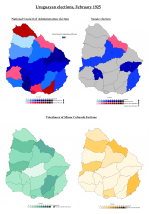
With his unprecedented electoral victory, Herrera became the true caudillo of the Partido Nacional, and looked like a shoe-in to win the Presidency in 1926. But until then, he had to serve as President of the Council - a role which, in opposition, the Blancos had always argued should be an administrative and apolitical one. Now he used it to score political points against the Colorado majority. One of his opponents was the outgoing President of the Council, Julio Maria Sosa, an unorthodox Batllista who had never quite received the full confidence of Batlle himself. He had announced his candidacy for the Presidency of the Republic in 1923, and was incessantly touring the town halls of the country to raise his profile for the big election. But Batlle had other ideas.
Towards the end of 1925, an election for the Chamber and a third of the Senate was held. From now on, lower house elections would be held on a single national constituency, with seats being allocated to factions, parties and Departments according to an arcane mathematical formula. The result of this was to give a boost to minor groups, especially those voting within the lema of a large party - but the Blanco Radicals also benefited, taking home two seats where before they would have struggled to get one. Surprisingly, the Vieristas managed to increase their vote from February, demonstrating that there were no hard feelings about handing victory to the ancient enemy.
The ‘Union Colorada de Durazno’ was a local alliance of Radicals and Riveristas, who combined to elect a Sosa supporter to the Chamber of Deputies. Do keep up.
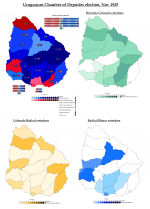
This proved that the Vieristas were absolutely integral to any Colorado pact which hoped to defeat the Nationalists in 1926 - and if the latter won, they would take not only the presidency, but also the majority on the Colegiado. Sosa hoped that he was sufficiently acceptable to the Radicals to lead the party to victory, but now, there was another Batllista candidate for President: Gabriel Terra. Terra was equally unorthodox, but that meant that he was equally appealing to the conservative Colorado sectors - and he had been a Brumista at the start of the decade, which meant that he had at least betrayed Batlle to his face. Batlle encouraged Terra to run for President against Sosa - but then he destroyed both of them in the press, accusing Sosa of cowardice in the 1904 civil war, and Terra of being a crypto-Catholic on account of the fact that he had attended his own daughter’s wedding ceremony.
The lack of any serious Batllista candidate for President transformed that role into a bargaining token with the minor factions, but there were two blockages in the way of an accord: firstly, Batlle wanted the top spot on the Council list for himself, and secondly, he wanted all Colorado Councillors to sign an agreement to vote as one rather than dealing with the Blancos. The Vieristas, of course, had split precisely because they rejected Batlle’s push for whipped votes. After much arguing and brinksmanship, the three parties came to an agreement barely a fortnight before the elections, leaving very little time to print the ballots. Batlle would go to the Council, but the second place would go to a Vierista, and the Presidential candidate would now be the conservative Riverista, Juan Campisteguy. There was also a second slate with pro-Sosa Batllistas voting for Sosa as President, and this was also supported by some Vieristas. This list, ‘For the Colorado Tradition’, got about a third of the Colorado votes, but its only achievement was to put Campisteguy over the line as the Colorado factions pooled their votes this time.
This time it was the Blancos’ turn to lose an election thanks purely to their own internal odium. The Blanco Radicals put up a no-hope ticket in this election, and still received 3,800 votes - well in excess of Campisteguy’s 1,500 vote margin over Herrera. More to the point, though, the Nationalists complained of a number of instances of electoral fraud, the largest of which involved 1,400 ballots in Minas being printed on slightly the wrong colour paper, which the opposition feared was an attempt to identify and intimidate voters. In reality, the printer just ran out of the right paper stock. But the new Electoral Court had partisan representation, and the Nationalist members of the Court blocked any adjudication on these issues until the end of February 1927 - and the new President had to be sworn in on the first of March. If no decision had been made by then, the Council could nominate one of its members as an interim President… but this body would be evenly split between the parties until the election results were approved, so it would be deadlocked. Which meant that the Senate would appoint an interim President until the Council could name an
official interim. And the Senate was largely Nationalist. Outgoing President Serrato moved a number of Army units to the outskirts of Montevideo to forcibly appoint Campisteguy if the situation arose, while Batlle plotted to use his own loyal Army officers to return to power himself at the head of a Junta - you may recall that his entire rationale for the Colegiado was that it would prevent coups and dictatorships.
As it was, though, the fact that the heavily Colorado Army was sitting outside the Electoral Court and the Senate had an invigorating effect on the Nationalists within, and Campisteguy was declared elected the evening before his inauguration.
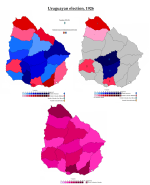
In the election to the Senate, the new Senator for Canelones (the Department surrounding Montevideo) was Pablo de Maria, an old member of the Constitutionalist Party who was now effectively an Independent - but he was elected by the Colorados on the electoral college, so I’ve marked him down as a Colorado. Meanwhile, the electoral college in Salto were unable to come up with a nomination for the entirety of this six-year term, meaning that Salto was without a Senator until 1933.
Name of the week: Eofelio de Dovittis (Colorado, Colonia) beats out his coreligionaries Rodolfo Scheckleton, Miguel Oficialdegui and the Riverista Felisberto Carambula.
